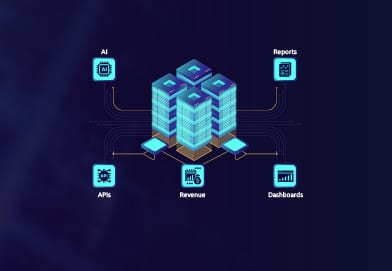Businesses generate massive amounts of data daily, but are they leveraging it to its full potential? Information is crucial, so we need data analytics more than ever.
As we move into 2025, its power will drive innovations and reshape business intelligence and strategic planning. Harnessing immense resources necessitates a forward-looking approach to keep pace with rapid technological advancements and data management growth.
Businesses and professionals must stay updated on the latest trends to remain competitive. This blog will cover nine key data analytics trends for 2025, providing valuable insights to help you leverage these changes for success and innovation.
How Enterprise Data Analytics Drives Business Success
Enterprise data analytics transforms raw data into meaningful insights that drive strategic decision-making and operational efficiency. By leveraging vast data, enterprises can uncover deep insights into operations, customer behaviors, and market dynamics, enabling process optimization, cost reduction, and enhanced customer satisfaction.
Advanced tools like machine learning and AI empower enterprises to predict trends, automate tasks, and personalize interactions. This fosters a data-driven culture, encouraging informed decision-making across all levels and ensuring every department benefits from actionable insights, driving overall business growth and sustainability.
What Is the Impact of Data Analytics on Small Businesses?
Small businesses use data analytics to drive growth, streamline operations, and enhance customer experiences. By leveraging cost-effective insights, they can compete with larger firms, identify market trends, optimize marketing, and make informed decisions. This transforms how they understand consumer behavior, forecast demand, and tailor services.
McKinsey predicts global data creation will grow to more than 180 zettabytes by 2025, higher than the 2020 report (64.2 zettabytes). This exponential data growth provides small businesses unparalleled opportunities to harness immense data resources, enabling them to stay competitive and foster continuous innovation.
How Data-Driven Insights Transform Small Businesses
This system also offers a competitive edge by fostering a culture of informed decision-making. Real-time data interpretation enables businesses to respond quickly to changes and proactively shape their strategies and best practices to anticipate market shifts.
As data analytics trends evolve, small businesses integrating data science technologies will better position themselves to innovate, stay agile, and secure their place in an increasingly numbers-driven marketplace. This transformative impact offers unparalleled growth opportunities, ensuring resilience and success in a dynamic economic landscape.
9 Trends in Data Analytics You Need to Know About
Below are the top data analytics trends shaping the future and driving these changes.
1. The Rise of Augmented Analytics
Augmented analytics blends human intuition with advanced artificial intelligence. Allied Market Research reports that the global market is projected to grow from $4,094 million in 2017 to $29,856 million by 2025, at a CAGR of +28.4%. This technology automates data preparation, insight generation, and explanation to make it accessible to a wider audience.
Enhanced data discovery and visualization tools enable business users to leverage sophisticated analytics regardless of technical expertise, fostering data democratization. Augmented analytics simplifies data interpretation, empowering employees at all levels to make decisions and fostering innovation and rapid growth.
As augmented analytics tools become increasingly sophisticated and user-friendly, the barriers to insightful and actionable data analytics will continue to diminish. This trend amplifies organizations’ potential to generate competitive advantages, revolutionizing how companies harness information to drive operational excellence and strategic insight.

2. Increased Focus on AI and ML
Generative AI and AI and ML revolutionize data analytics, enabling deep learning, natural language processing, predictive analytics, and automated decision-making. These technologies empower businesses to unlock precise insights, enhance operational efficiency, and deliver timely, actionable data intelligence.
Machine learning algorithms refine predictions, enabling businesses to adapt to changing market conditions and consumer behaviors. AI identifies subtle trends within vast data sets, providing analysis beyond human capabilities for faster, more effective business outcomes. According to Grand View Research, the global AI market is expected to reach $1,811.75 billion by 2030, growing at a CAGR of +36.6% from 2024 to 2030.
The use of AI and ML in data analytics tools democratizes access to advanced analytics, fostering a culture of strategies across all organizational levels. This paradigm shift is both a technological advancement and a strategic imperative for future-proofing businesses, ensuring sustained growth and competitive advantage.

3. Data Privacy and Ethical Considerations
As data analytics trends rapidly evolve, the nexus between privacy, ethics, security, and technology becomes increasingly critical. Organizations must navigate the delicate balance of leveraging vast data while ensuring data protection and safeguarding user privacy. Regulatory frameworks worldwide are tightening, compelling firms to adhere to stringent privacy laws.
Ethical considerations are fundamental to sustainable practices, including ensuring robust data observability. Small and large companies must:
- Build robust mechanisms to ensure transparency
- Adopt fair practices to mitigate biases
- Foster trust among stakeholders
4. Real-Time Analytics
By 2025, real-time analytics will redefine data-driven decision-making, offering organizations unparalleled insights and driving strategic growth. The ability to process information in real time enhances operational efficiency and allows for immediate responses to market changes, keeping businesses agile and competitive.
Technologies such as cloud computing, data fabric architectures, advanced data integration platforms, and AI-powered analytics tools are at the forefront of this transformation. These innovations enable businesses to quickly identify trends and foster rapid innovation across various industries.
This trend particularly impacts the retail, finance, healthcare, and manufacturing industries, where sharing facilitates real-time analytics and fosters seamless operations. Embracing real-time analytics in these sectors significantly improves customer experience, swift issue resolution, and the ability to seize new ways. This pivotal shift highlights the critical role of timely insights in shaping the future of business.
5. Data Literacy as a Core Competency
Fostering a culture will be essential for organizational success by 2025. Elevating data literacy levels will be a primary strategic objective, as employees proficient in interpreting data will drive innovation. According to Forrester, 70% of employees are expected to work heavily with data by 2025, up from just 40% in 2018.
Organizations should invest in programs and initiatives to enhance data literacy and promote data sharing, including:
- Training sessions and workshops
- Continuous learning opportunities
- Access to educational resources
- Mentorship programs with a data analyst
- Practical tools for analysis
Prioritizing data literacy will transform business operations to enable comprehensive understanding. This shift will enhance collaboration, productivity, and sustained success.

6. Leveraging Big Data for Competitive Advantage
Big data converts vast information into impactful business strategies, enabling companies to stay ahead effortlessly with real-time decision-making. According to Market Research Future, the Big Data Software Market is projected to grow from $232.74 billion in 2024 to $686.08 billion by 2032, with a CAGR of +14.47%.
Predictive analytics from big data helps businesses anticipate market trends and refine their strategies accordingly. This capability allows enterprises to personalize customer interactions, enhancing loyalty and engagement.
Leaders who invest in big data technologies uncover new revenue streams, optimize costs, and refine operations to boost efficiency and profitability. The future belongs to those who master big data, driving unparalleled growth and innovation.

7. Integrating IoT With Data Analytics
The convergence of IoT, edge computing, and data analytics transforms business operations. IoT devices generate vast data that can be harnessed for deep insights, enabling companies to optimize operations, drive innovation, and gain a competitive edge. Real-time data from IoT sensors allows for precise decision-making in areas like predictive maintenance, smart city initiatives, and personalized marketing.
Developing robust frameworks is crucial to fully capitalize on these advancements. According to ABI Research, revenue from IoT data and analytics services will grow 19% annually, from $91.9 billion in 2025 to almost $218 billion by the decade’s end. Businesses integrating these technologies will lead their markets, leveraging IoT-driven insights to fuel growth and innovation.
8. Quantum Computing
Quantum computing is set to revolutionize data analytics by solving complex problems at unprecedented speeds. Using quantum bits can simultaneously process vast amounts of data, enabling businesses to tackle challenges like optimizing supply chains and discovering new pharmaceuticals. McKinsey reports that quantum computing alone could account for nearly $1.3 trillion in value by 2035.
Integrating quantum computing will lead to more accurate predictive models and faster data processing. Financial, healthcare, and logistics industries will gain a competitive edge through enhanced decision-making capabilities.
To fully leverage quantum computing, businesses must invest in research and development and train their workforce to utilize it. Early adopters will be well-positioned to lead in their markets, driving innovation and growth.
9. Data-as-a-Service (DaaS)
Data-as-a-service (DaaS) revolutionizes how businesses access and utilize data through cloud-based platforms, offering high-quality data without extensive infrastructure investments. This model provides flexibility, scalability, and cost-efficiency. According to Future Market Insights, the overall demand for DaaS is projected to grow at a CAGR of 23.4% between 2023 and 2033, reaching approximately $85,619.0 million by 2033.
DaaS is particularly beneficial for industries that require real-time data analysis, such as finance, healthcare, and retail. Leveraging DaaS can help businesses make informed decisions quickly, respond effectively to market changes, and gain a competitive edge.
As the demand for data-driven insights continues to grow, the adoption of DaaS is expected to rise. Companies that embrace this model will be better equipped to navigate the complexities of the modern landscape, driving innovation and growth.

How to Address Challenges in Data and Analytics Trends
Overcoming challenges in data analytics trends requires strategic innovation and a proactive approach. Here are key areas to focus on:
Enhance Data Quality
Poor quality can lead to erroneous insights and flawed decision-making. Organizations must invest in robust data governance frameworks to ensure accurate, consistent, and reliable data. Integrating advanced tools for real-time cleansing and validation is also essential.
Ensure Data Privacy
As data volume grows, so does the risk of breaches and non-compliance with regulations. Encrypting data at various stages and employing comprehensive data access controls are crucial. Additionally, organizations should regularly conduct security audits and updates to maintain integrity.
Bridge the Skills Gap
The skills gap is a significant barrier. Investing in continuous workforce training, fostering partnerships with educational institutions, and adopting user-friendly analytics platforms can help bridge this gap.
Prepare Your Business for Emerging Data Analytics Trends
Transformation begins with a clear, strategic vision. An actionable data strategy creates a robust framework to address emerging data analytics trends. At Data-Sleek, we help businesses navigate transformation with tailored data analytics solutions that uncover hidden opportunities.
Our services include developing customized strategies, optimizing Tableau dashboards, building efficient, scalable, and stable data infrastructures, and transforming data into actionable insights. Contact us to leverage the latest trends, drive growth, and achieve competitive advantage!







